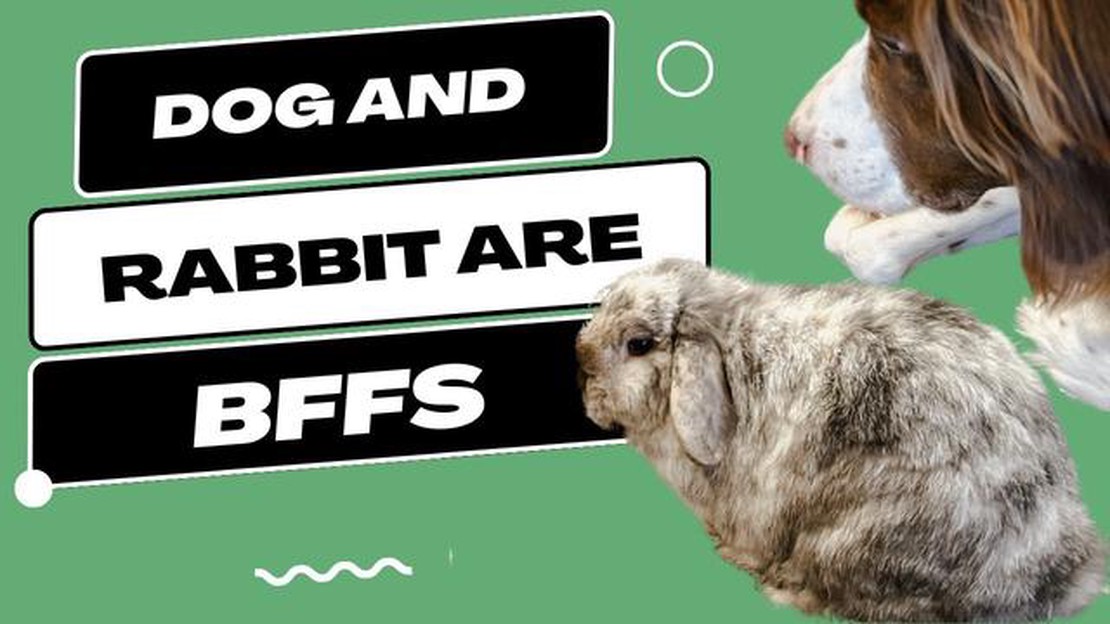How to Deal With Maggots in Your Dog's Food Bowl - A Step-by-Step Guide
Maggots In Dog Food Bowl Maggots in your dog’s food bowl can be a disgusting and unsanitary problem. Not only are maggots a potential health risk for …
Read Article
Are you worried about introducing your dog to your new pet rabbit?
Introducing different pets to each other can be a nerve-wracking experience, especially when one of them is a natural predator. However, with a few essential tips and careful supervision, you can create a harmonious environment for your dog and rabbit to coexist.
Here are some essential tips to ensure a positive introduction:
1. Gradual introductions: Rather than throwing your dog and rabbit together all at once, it’s important to introduce them slowly and in a controlled manner. Start with short, supervised interactions and gradually increase the time as they become more comfortable with each other.
2. Create a safe space: Give your rabbit their own dedicated space where they can retreat to if they feel threatened. Make sure this area is secured and inaccessible to your dog, providing your rabbit with a sense of safety and security.
3. Positive reinforcement: Reward both your dog and rabbit for calm and friendly behavior towards each other. Offer treats, praise, and affection to encourage positive associations and reinforce good behavior.
4. Separate feeding areas: Dogs can be possessive of their food, which can lead to conflict with a rabbit. It’s important to provide separate feeding areas to prevent any potential aggression or competition over food.
5. Supervision is key: Always supervise interactions between your dog and rabbit, especially in the early stages of their introduction. This allows you to intervene if necessary and ensures the safety of both pets.
Read Also: Tick Egg Sack On Dog: How to Identify and Remove Them Safely
Remember, every dog and rabbit is different, and the introduction process may take time. With patience, consistency, and these essential tips, you can help foster a harmonious relationship between your dog and rabbit.
Welcome to Understanding Pet Behaviors, your one-stop destination for learning about animal behavior and helping you create a harmonious environment for your pets.
At Understanding Pet Behaviors, we specialize in studying and analyzing the behaviors of various pets, including dogs, cats, rabbits, and more. Our team of experts has years of experience observing and understanding the unique traits and characteristics of different animals.
Here are some key benefits of choosing Understanding Pet Behaviors:
Understanding Pet Behaviors is committed to helping you build strong, positive relationships between your pets, ensuring a happy and safe environment for all. Browse our website and take the first step towards creating a harmonious pet household today!
When introducing your dog and rabbit, it is essential to create a safe environment to prevent any potential harm. Here are some tips to help you create a safe environment for your pets:
Read Also: How Long Should You Stay Mad At Your Dog: Tips for Handling Canine Misbehavior
Remember, each dog and rabbit is unique, and their compatibility may vary. It is important to monitor their interactions closely and be prepared to separate them if necessary. With proper introduction and a safe environment, you can help create a harmonious relationship between your dog and rabbit.
When introducing your dog and rabbit, it is crucial to maintain constant monitoring and supervision to ensure the safety of both pets. Here are some essential tips for monitoring and supervising their interactions:
Remember, each dog and rabbit is unique, and the introduction process may take time. Patience, consistency, and careful monitoring are key to fostering a safe and peaceful relationship between your pets.
Yes, this book provides essential tips and guidance on how to introduce your dog and rabbit in a safe and successful manner.
The book offers different techniques and strategies to help you prevent any harm to your rabbit, such as gradual introductions, supervised interactions, and proper training for your dog.
Yes, it is possible for a dog and rabbit to peacefully coexist. With proper introductions, consistent training, and supervision, they can learn to get along and even become good friends.
While some dog breeds have a higher prey drive than others, it ultimately depends on the individual dog and their training. The book provides guidelines for assessing your dog’s behavior and tips for managing potential risks.
Maggots In Dog Food Bowl Maggots in your dog’s food bowl can be a disgusting and unsanitary problem. Not only are maggots a potential health risk for …
Read ArticleCan Dogs Eat Pheasant Many dog owners enjoy hunting and may wonder if it is safe to share their game with their furry friends. Pheasant is a popular …
Read ArticlePolice K9 Trainer Jobs Are you passionate about working with dogs? Do you have a strong desire to make a positive impact in your community? If so, we …
Read ArticleCan You Mail A Puppy When it comes to transporting a puppy, many pet owners wonder if it is possible to mail their furry friend. While it may seem …
Read ArticleDog Ate Ice Pack If your dog has eaten an ice pack, it is important to take immediate action to ensure their safety and prevent any potential …
Read ArticleWho Originally Wrote Who Let The Dogs Out “Who Let The Dogs Out” is a catchy and anthemic song that has become an international phenomenon. But the …
Read Article